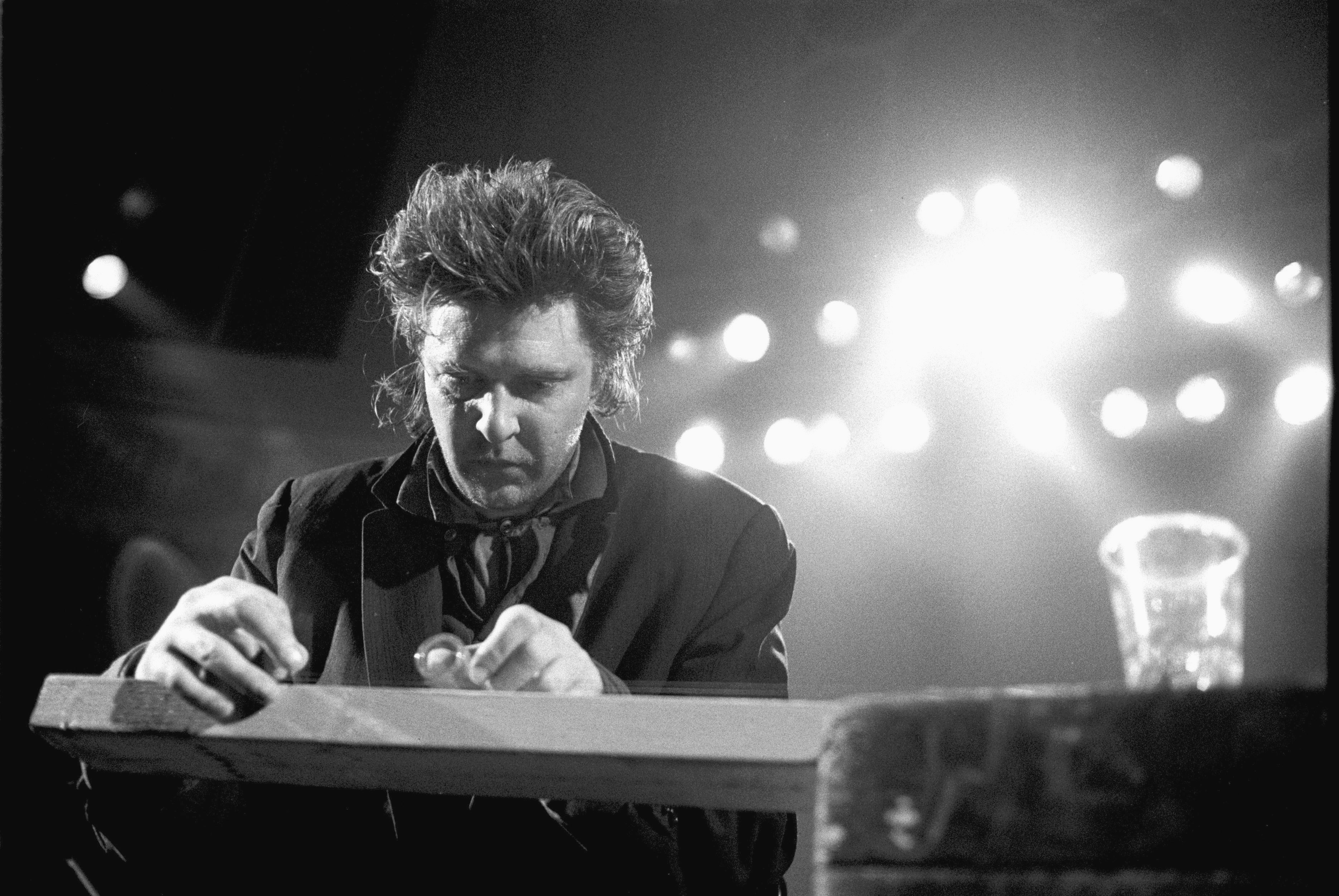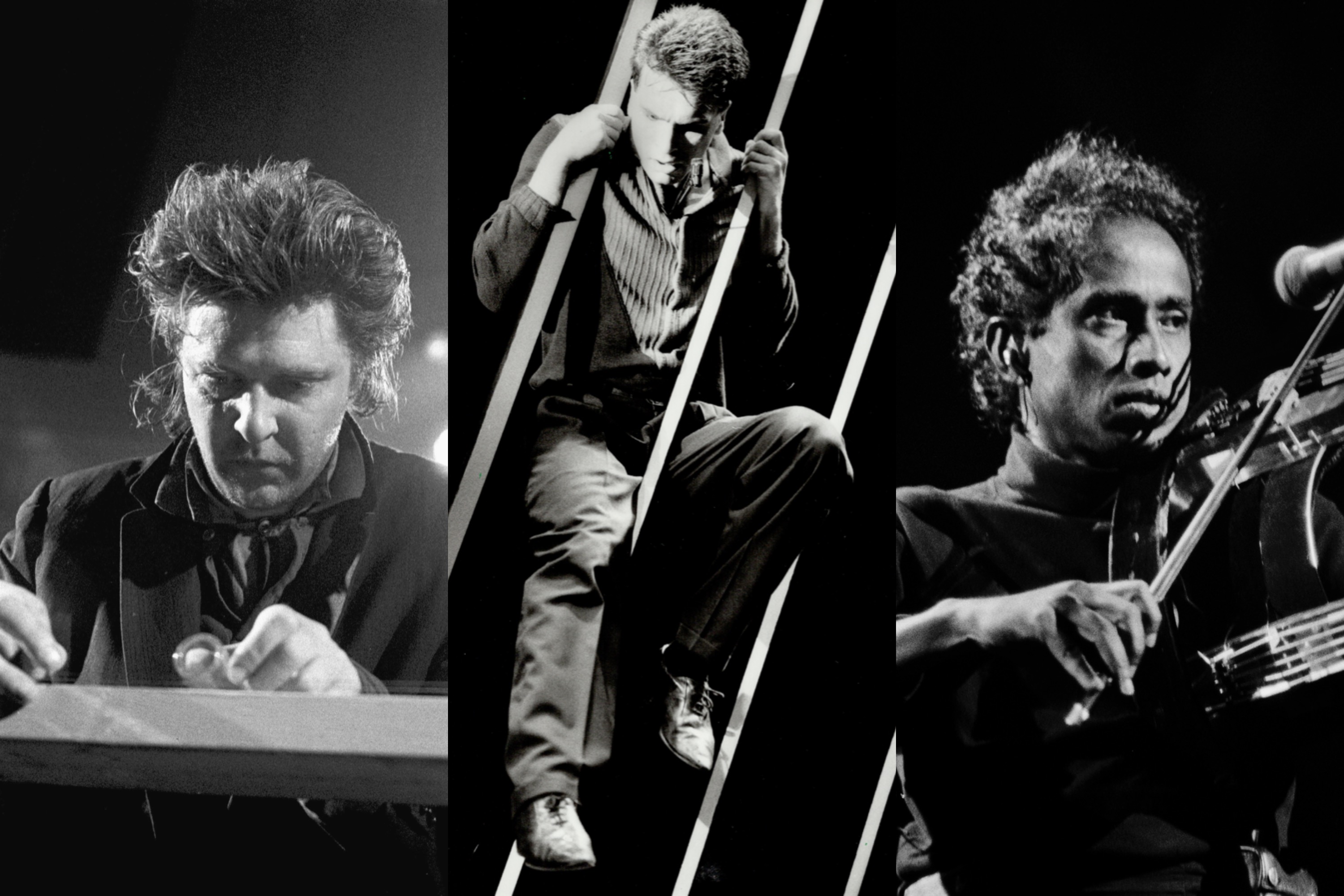This column originally appeared in the September 1985 issue of SPIN.
The first thing you noticed when you turned over the postcard was the swastika. It was surrounded by parallel lines and numbers. Glenn Branca, its composer, described it as a “score,” a way of representing music on paper. That was three years ago. My first reaction was who else? Branca was being touted in the press as the new “bad boy of music,” a renegade punk who may or may not’ve been a serious composer. Three years later, Branca still seems to fit the part, wearing violet sunglasses, black clothes, and an unruly shock of dark hair.
In the amorphous field of new music, Glenn Branca is one of the most controversial figures. Since the late ’70s, he’s been working in a gray area somewhere between avant-garde rock and avant-garde classical music, producing along the way five “symphonies” for large groups of electric guitars or specially constructed keyboards and drums. This is music to make anyone expecting a traditional symphonic work run, shrieking, from the hall.
Branca arrived early for this interview. You’d think a guy whose music slams into the listener with all the force of the L.A. Raiders’ secondary would saunter in late, drop a few four-letter words, and walk out. I knew it had happened before. “The most abrasive, difficult person I’ve ever had to talk to,” a colleague had described him.
Well, he did saunter in and drop one or two choice Anglo-Saxon words, but the only thing abrasive about him was his laugh—a sharp snorting sound that at first scared the hell out of me. Branca has little time or patience for interviews, and he’s intolerant of the stupid questions the loud, pulsing chords of his electric guitar pieces seem to inspire in befuddled interviewers. If you get him talking, he’s got a lot to say, and he doesn’t avoid controversy. Take the swastika: “I was trying to visualize a three-dimensional music,” he drawls, “but I felt that was the most powerful and interesting score I had developed, and I saw no reason not to show it.” Actually, there was a method to Branca’s madness, as we’ll see in a moment.
“I’m not interested in shocking people simply for the sake of shocking them,” Branca says. “That’s not too difficult to do, really.” Seems like a reasonable enough statement, right? “On the other hand,” he continues, “a little excitement over my music is certainly nice.”
“A little excitement” is a little misleading. To most musicians, rave reviews in the newspaper are a little excitement; selling out a concert is a little excitement. Being called a “musical fascist” by one of the most important American musicians of the century, alienating half the audience with music played at brainscrambling volume, and offending most of the musical community with postcards bearing swastikas does not usually qualify as “a little excitement.”
Branca has a fearsome reputation: he is said to be rude, brash, surly, vulgar—in short, all the things his music is alleged to be. In fact, he is an intelligent musician with some intriguing ideas. He snarls, yes, and his voice, a sort of younger version of William Burroughs’, may sound vaguely sarcastic at first, but he is a lively speaker. While some people find his music too loud and violent, to others it’s invigorating stuff—music with cojones.
Some of his recent works use specially tuned keyboards, but Branca is most identified with the electric guitar. Or guitars, to be precise. A Branca piece may incorporate seven or more electric guitars, producing huge blocks of sound, while his longtime associate Stephen Wischerth pounds away at the drums. Friendly critics ramble on about “visceral impact” and “physical sonic effects.” “That description can be made about practically any hardcore band,” says Branca. “That’s the intention of the music; no one would even consider saying that about a hardcore band. It’s a given. The thing is, I’m not working in that form, and that’s where I run into problems.”
The sound of a battalion of guitar players is something few listeners have any enthusiasm for. “It isn’t just the guitars; it’s really a matter of the volume knob,” says Branca. “I don’t need guitars to get loud. In the second, third, and fourth symphonies, there were very few guitars. The real problem is the volume. With a younger audience that’s used to rock concerts, it’s not a problem at all. For an older audience that isn’t interested in rock, its a very big problem. At ridiculously low volume levels, many people think it’s outrageously loud! But many young people think it’s not nearly loud enough.”
Branca wouldn’t have this problem if he had stayed in rock, but he never intended to be a rock musician. Branca worked in Boston during the early ’70s with a theater group, using music in the context of the theater. “I was actually working with acoustic instruments at that time,” he says. Now that, say I, is something I’d love to hear. “Uh, maybe not,” he says. “It wasn’t sweet.” In 1973, Branca heard the so-called minimalist music of Steve Reich and Philip Glass. “That had an incredible effect on me,” he recalls.
“This was the direction I was going in, and these people had gone much farther than I had at the time.” Branca moved to New York in 1976, when the punk movement was in full swing. He and Jeffrey Lohn, another influential figure among young New York musicians, formed a punk band called Theoretical Girls. Branca and Lohn were putting together a theater group when they got the chance to form a band and get a performance space. “In three weeks we had to find the instruments, amplifiers, and musicians and write the songs,” laughs Branca. “So the first set was, well, kind of funky. Was Theoretical Girls a rock band? It definitely started out that way. If you heard the early concerts, it was real three- or four-chord stuff, with a bit of a twist. But people liked it, and we liked it. So very quickly we started to make our own way.”
Branca has always been interested in formal structures, something more common to classical composers than to punk rockers. So Theoretical Girls soon evolved into something more than a rock band. In the late ’70s Branca began to perform and record on his own, using multiple electric guitars and drums; also he began to appear in serious new music forums, like the annual New Music America Festival and the Brooklyn Academy of Music. That’s when the real brouhaha started. Many people were not ready for the startling sight of rock instruments on a concert stage and the equally startling sound. “People talk about the violence in the music, and many times someone will interview me and all we’ll talk about is the violence, and I finally end up saying ‘O.K., yeah, the violence is definitely there, but let’s talk about the other 90 percent.'”
Unsurprisingly, Branca’s music is often misunderstood. The most infamous misunderstanding occurred about three years ago. AS part of a new music concert, Branca performed a piece called Indeterminate Activity of Resultant Masses. At a symposium the day after the concert, John Cage, the granddaddy of 20th-century avant-garde music, whose work has offended narrow-minded concertgoers for three generations, was himself offended by Branca’s piece, and called Branca a musical fascist.
“It was certainly a hot item,” Branca deadpans. “The symposium was at 11 AM, and I got there a little late. I walked in and Cage was attacking my piece. At great length! I was in complete shock. And he didn’t stop. I couldn’t believe it was happening. Cage himself has worked with high volume; in earlier years he conducted ensembles of cacophonous, ugly, stupid music. I mean, what is he talking about? Is he senile? Of course he’s not senile, we know that. What is going on? I just don’t know.” Branca’s response to the “musical fascist” remark was even more controversial than Cage’s original attack. For a number of years. Branca has been experimenting with the “harmonic series,” the way the acoustic vibrations of notes line up in nature. The piano, for example, is tuned for convenience, not according to where the notes lie naturally. So Branca uses specially designed keyboards tuned specifically to the harmonic series. Since the harmonic series cant be written down using the usual notes-on-a-staff method, Branca experimented with different geometrical figures to represent the music’s structure.
The Brooklyn Academy of Music asked him for some written notation to include on a postcard announcing its upcoming concerts. “I showed them a number of scores.” he remembers, and this one particular score was the most interesting at that point. I was working on an idea for the harmonic series, a geometrical kind of dynamic, and the shape of the swastika just kind of appeared. It represented a spiral development in the work. We’re talking about a few months alter the Cage thing, and here I am at 3 in the morning deriving a swastika from one of my scores!
“It seemed like a perfect answer to Mr. Cage. And that’s what it was intended to be.” Copies of the postcard with the swastika score went out to members of New York’s musical community, and if Branca expected “a little excitement,” he got it. Several prominent musical figures were outraged. “I really didn’t mean to use it for shock value,” he insists. “If I knew that Laurie Anderson and Steve Reich were going to be so upset by it—and in retrospect it’s obvious why they were—if I had known, I absolutely would not have used it. I really didn’t want that to happen. I did use the image in relation to what Cage had said, but it had nothing to do with Hitler or fascism at all. And that symbol still exists in practically every basic geometry book. They’re not gonna tear that image off the page simply because Hitler decided to use it.”
Branca revels in the ambiguities between rock and classical, electric and acoustic, and so on. Maybe the swastika wasn’t ambiguous enough. But the titles of his second and third symphonies are. Symphony #2 is entitled The Peak of the Sacred; Symphony #3 is Gloria. Religious titles perhaps? “Gloria could be interpreted a couple of ways,” explains Branca, “and that’s what I liked about it. I think ‘Gloria’ was probably the first rock sing I ever learned to play on the guitar; it was a sort of an anthem of the times. At the same time, it’s got all these connotations in classical music and religious literature, and I do like playing with these ambiguities.” The Peak of the Sacred is an excerpt from a perplexing quote about materialism by 19th-century German philosopher Ludwig Feuerbach.
Branca’s Symphony #3 is his most recent recording. Using a number of retuned keyboards, mallet guitars, one bass, and Wischerth’s powerhouse drumming, he has produced a piece that’s as intense as his earlier works with guitars and has some beautiful bell-like effects as well. It’s based on the harmonic series, so the tuning takes a moment to adjust to, but it is one of his most powerful works. “The instruments were built, the compositional concept was developed, and the piece was written in five months,” Branca says. “I just about had a nervous breakdown; the fact that the piece got on stage at all was a miracle.”
Musicians aren’t in the habit of saying they’re not pleased with their recordings, but Branca admits he’s not always satisfied with his works. “People will find this hard to believe, maybe even impossible to believe, but I’m actually a perfectionist. And it’s difficult for me to get on stage with something that’s not ‘there’ yet. But with the harmonic series, I really want to capture every aspect of it in each piece, and it’s impossible at this point; what’s happening on paper has developed way beyond what can possibly happen musically.”
Many of Branca’s earlier recordings, even if they’re not based on the harmonic series, seem to be musical examples of formal structure. Lesson #1 for electric guitar is an early example; a later album called The Ascension is probably the most effective guitar music Branca has done. Once again the title is ambiguous, as the album cover features a Robert Longo painting of one young man collapsing, as if shot, into another’s arms. The title, combined with the gripping artwork, leaves room for all kinds of interpretations. The album’s title track is beautiful in the same harshly brilliant way a picture of Antarctica is.
Branca is now returning to the electric guitar. His Symphony #5 uses seven guitars that have been refretted to fit his tuning system. And several works in progress will also use them.
“If you want to find fascism in my work,” says Branca, “it’s there. If that’s what you want. But I don’t think of my work like that at all—if anything, it’s the absolute antithesis of that.” So if you’re looking for a little excitement, try some of Branca’s music. He has recorded for two small New York-based labels, Neutral and 99 Records. If you don’t have access to an alternative record store, they can be found in the mail-order catalog of New Music Distribution Service, 500 Broadway, NY, NY 10012, 212-925-2121. Hear what all the fuss is about. You may even like his music.





